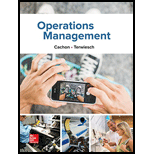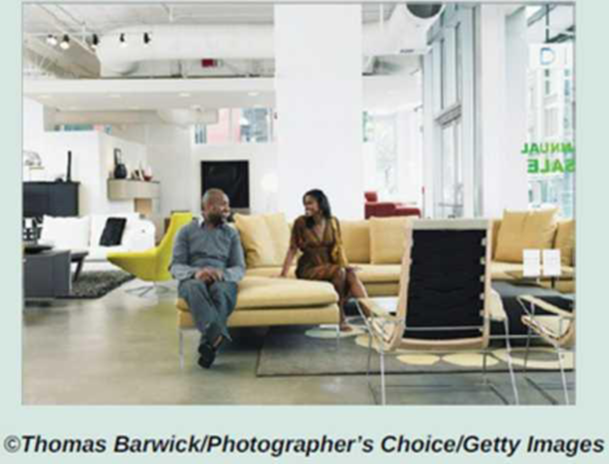
Concept explainers
CASE WARKWORTH FURNITURE1
Warkworth Furniture specializes in environmentally friendly and sustainable furniture. One of its products, the TePaki desk, uses bamboo for the surface and recycled aluminum for the supports. The desk is made in its factory in Vietnam and shipped to all of its 30 stores throughout the United States, primarily in the large urban areas on either coast. Karen Williamson, the owner of Warkworth Furniture, is struggling with how it should organize its supply chain.
Currently, it ships the desks from Vietnam to the United States via ocean carrier. Once they arrive in the United States, they are shipped via a third-party carrier to each store. It usually takes 10 weeks between when an order is placed with the factory and when the product is received in a store.
The TePaki desk may be eco-friendly, but it isn’t wallet friendly: Each desk costs Warkworth $325 to make and it sells the desk for $850. Nevertheless, Warkworth has been able to identify a market segment of customers that value the look of the desk and what it represents. Across its stores, it sells six desks per week, or 0.2 desk per week per store.
Given the upscale nature of its business, Warkworth’s stores are located in nice areas that unfortunately have high rents. Consequently, between the opportunity cost of capital and the cost of physical space, Karen estimates that it costs Warkworth $150 to hold each TePaki desk in one of its stores for one year. It would be a financial disaster if each desk actually spent the entire year in inventory in a store, but the $150 does represent the true cost of holding a desk in a store for that period of time.
Shipping a TePaki desk from Vietnam to a store costs Warkworth $80 per desk, about $40 for the ocean portion of the journey and $40 for the land portion within the United States.
Andy Philpot, Warkworth’s director of operations, has been arguing for some time that Warkworth should set up a distribution center in southern California to receive products from Asia, and from there distribute them to its various stores. Warehouse space is much cheaper than prime retail space. Hence, the holding cost per TePaki desk per year in a warehouse would only be $60. The only problem with this approach, according to Andy, is that the total shipping cost from factory to store could increase by $8 per desk due to the extra handling and shipping distance once all of the desks are routed through a distribution center.
Karen understands why the distribution center approach could make sense, but she worries about getting all of the execution done right. Instead, she suggests that it ship all of the desks directly to the stores as it currently does, but then ship product between stores as needed. The only problem with that approach is that it probably will cost it about $40 per desk to ship from one store to another.

To add to the discussion, Kathy White, Warkworth’s marketing director, is concerned with how these ideas will affect the desks’ instore availability. She proudly reminds everyone that Warkworth currently has a .99 in-stock probability for the TePaki desk. Andy, a typical ops guy, quips that it could save a ton if it were willing to make its customers wait a week or so to get their desk delivered to the store from a distribution center.
Say Warkworth listened to Andy and didn’t hold inventory at die stores. Instead, inventory would be held in a distribution center and shipped to the stores as needed. How much would it save in inventory holding costs with this strategy?
Case summary:
Company WF specializes in furniture that are environmental friendly and sustainable in nature. The new desk TePaki is eco-friendly but it is costlier than conventional desks. Person AP is the director of operations looking to setup a distribution channel in the southern part of City C to receive products Asia. But, they are many points to consider before the move is actually made.
To determine: The inventory holding costs saved with the strategy.
Explanation of Solution
Given information:
Number of stores (N) = 30
Lead time (L) = 10 weeks
Production cost (P) = $325 per desk
Selling price (S) = $850 per desk
Weekly sales (d) = 6 desks or 0.2 desk per week per store
Holding cost (H) = $150 per desk per year
Shipping cost (C) = $80 per desk
Ocean part cost (OC) = $40
Land part cost (LC) = $40
New system:
Lead time (L) = 1 week
Holding cost (H) = $60 per desk per year
Increase in shipping cost (IC) = $8 per desk
Cost of shipping from store to another (SC) = $40
In-stock probability (IP) = 0.99
New system:
Calculation of demand over (L+1) weeks:
The in-stock probability is 0.99, therefore, the base stock level must be selected so that the in-stock probability is satisfied. The desired probability lies in the base stock level of 2.
With a base stock level of 1, and the probability of 0.99 the average inventory from the Poisson table is 1.61. The total holding costs are calculated as shown below:
The average inventory is 48.3.
Holding cost per desk:
Every year they operate for 52 weeks, and 6 desks are sold per week. Therefore, the holding cost per desk will be:
Distribution center:
Apart from this, the distribution center must also hold inventory. The lead time is 10 weeks. The average weekly demand over the lead time would be:
The demand distribution is centered with a mean of 66 desks. The standard deviation (SD) is calculated as shown below:
The mean is substantially greater than 20, and so the demand can be approximated with normal distribution. From the distribution table, to achieve an in-stock probability of 0.99, the z-value is 2.4. The base stock level is:
The average inventory for a z-value of 2.4 is calculated by using the I (2.4) value from the distribution table. Therefore, the average inventory is
The holding cost of the distribution center is calculated as shown below:
Holding cost per desk:
Every year they operate for 52 weeks, and 6 desks are sold per week. Therefore, the holding cost per desk will be:
The cost per desk at the distribution center is $3.75. While, the cost per desk at the stores is $23.22. If the customers are willing to wait, the Company can save an additional cost of $23.22 per desk.
The inventory holding costs saved with the strategy is $23.22.
Want to see more full solutions like this?
Chapter 14 Solutions
Operations Management
Additional Business Textbook Solutions
Fundamentals of Financial Accounting
Gitman: Principl Manageri Finance_15 (15th Edition) (What's New in Finance)
Principles of Operations Management: Sustainability and Supply Chain Management (10th Edition)
Financial Accounting, Student Value Edition (5th Edition)
Operations Management: Processes and Supply Chains (12th Edition) (What's New in Operations Management)
Horngren's Cost Accounting: A Managerial Emphasis (16th Edition)
- Prepare a graph of the monthly forecasts and average forecast demand for Chicago Paint Corp., a manufacturer of specialized paint for artists. Compute the demand per day for each month (round your responses to one decimal place). Month B Production Days Demand Forecast Demand per Day January 21 950 February 19 1,150 March 21 1,150 April 20 1,250 May 23 1,200 June 22 1,000' July 20 1,350 August 21 1,250 September 21 1,050 October 21 1,050 November 21 December 225 950 19 850arrow_forwardThe president of Hill Enterprises, Terri Hill, projects the firm's aggregate demand requirements over the next 8 months as follows: 2,300 January 1,500 May February 1,700 June 2,100 March April 1,700 1,700 July August 1,900 1,500 Her operations manager is considering a new plan, which begins in January with 200 units of inventory on hand. Stockout cost of lost sales is $125 per unit. Inventory holding cost is $25 per unit per month. Ignore any idle-time costs. The plan is called plan C. Plan C: Keep a stable workforce by maintaining a constant production rate equal to the average gross requirements excluding initial inventory and allow varying inventory levels. Conduct your analysis for January through August. The average monthly demand requirement = units. (Enter your response as a whole number.) In order to arrive at the costs, first compute the ending inventory and stockout units for each month by filling in the table below (enter your responses as whole numbers). Ending E Period…arrow_forwardMention four early warning indicators that a business may be at risk.arrow_forward
- 1. Define risk management and explain its importance in a small business. 2. Describe three types of risks commonly faced by entrepreneurs. 3. Explain the purpose of a risk register. 4. List and briefly describe four risk response strategies. (5 marks) (6 marks) (4 marks) (8 marks) 5. Explain how social media can pose a risk to small businesses. (5 marks) 6. Identify and describe any four hazard-based risks. (8 marks) 7. Mention four early warning indicators that a business may be at risk. (4 marks)arrow_forwardState whether each of the following statements is TRUE or FALSE. 1. Risk management involves identifying, analysing, and mitigating risks. 2. Hazard risks include interest rate fluctuations. 3. Entrepreneurs should avoid all forms of risks. 4. SWOT analysis is a tool for risk identification. 5. Scenario building helps visualise risk responses. 6. Risk appetite defines how much risk an organisation is willing to accept. 7. Diversification is a risk reduction strategy. 8. A risk management framework must align with business goals. 9. Political risk is only relevant in unstable countries. 10. All risks can be eliminated through insurance.arrow_forward9. A hazard-based risk includes A. Political instability B. Ergonomic issues C. Market demand D. Taxation changesarrow_forward
 Purchasing and Supply Chain ManagementOperations ManagementISBN:9781285869681Author:Robert M. Monczka, Robert B. Handfield, Larry C. Giunipero, James L. PattersonPublisher:Cengage Learning
Purchasing and Supply Chain ManagementOperations ManagementISBN:9781285869681Author:Robert M. Monczka, Robert B. Handfield, Larry C. Giunipero, James L. PattersonPublisher:Cengage Learning Practical Management ScienceOperations ManagementISBN:9781337406659Author:WINSTON, Wayne L.Publisher:Cengage,
Practical Management ScienceOperations ManagementISBN:9781337406659Author:WINSTON, Wayne L.Publisher:Cengage,- MarketingMarketingISBN:9780357033791Author:Pride, William MPublisher:South Western Educational Publishing
 Contemporary MarketingMarketingISBN:9780357033777Author:Louis E. Boone, David L. KurtzPublisher:Cengage Learning
Contemporary MarketingMarketingISBN:9780357033777Author:Louis E. Boone, David L. KurtzPublisher:Cengage Learning




